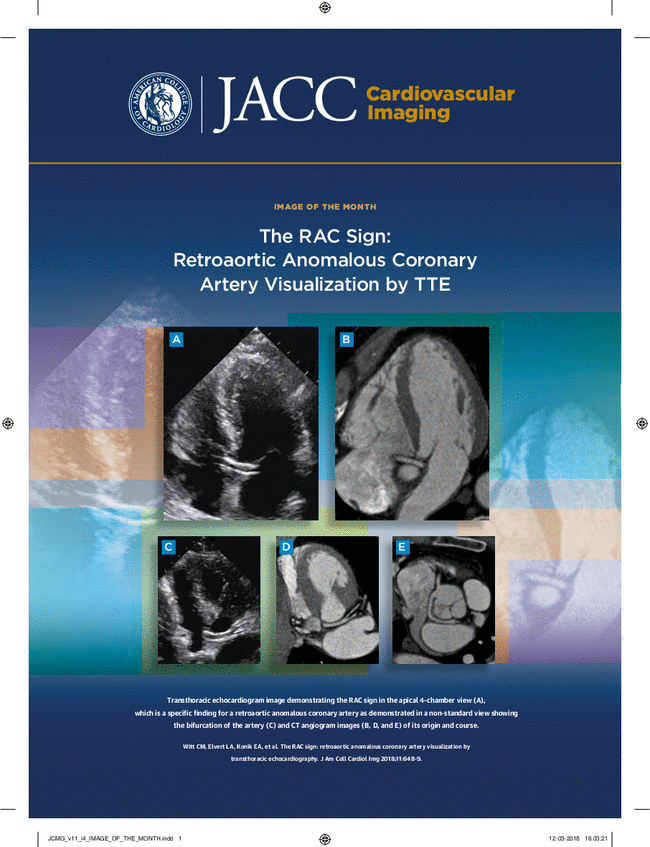Prediction of Left Ventricular Filling Pressures Using Natural Shear Waves
IF 15.2
1区 医学
Q1 CARDIAC & CARDIOVASCULAR SYSTEMS
引用次数: 0
Abstract
Background
Increased myocardial stiffness can lead to diastolic dysfunction, resulting eventually in increased left ventricular filling pressures (LVFPs). The clinical assessment of left ventricular (LV) diastolic function is challenging. Shear wave elastography is a novel method based on tracking shear waves, such as those induced by mitral valve closure (MVC), using high frame rate (HFR) echocardiography. The propagation velocity of shear waves is directly related to myocardial stiffness.
Objectives
This study investigated whether shear wave velocity at MVC is related to invasively measured LVFP.
Methods
Eighty-five patients were prospectively enrolled. Left ventricular mid-diastolic pressure (LVMDP) and left ventricular end-diastolic pressure (LVEDP) were invasively measured. HFR (average frame rate: 1,050 ± 220 Hz) and conventional echocardiography were performed immediately after catheterization. Shear wave velocity at MVC was measured in the anteroseptal wall. The findings were compared with conventional echocardiographic parameters and the multiparametric 2021 guideline-recommended algorithm for the estimation of LVFP. The direct response of shear wave velocity at MVC on changing LV filling pressures was tested in a group of 16 patients with acutely decompensated heart failure (DHF) on admission and after diuretic therapy.
Results
Single conventional echocardiographic parameters correlated moderately with LVFP (Pearson r between 0.39 and 0.58) and had a moderate ability to detect elevated LVFP (AUC between 0.66 and 0.79). This was similar for the multiparametric guideline algorithm (LVMDP AUC: 0.78; LVEDP AUC: 0.60). In comparison, shear wave velocities at MVC as a single measure correlated strongly with LVEDP (r = 0.71; P < 0.001) and had an similar ability to predict elevated LVMDP (AUC: 0.79; sensitivity: 87%; specificity: 65%) and an excellent ability to predict elevated LVEDP (AUC: 0.95; sensitivity: 92%; specificity: 94%) when a cutoff value of 4.8 m/s was used. In DHF patients, we observed a significant decrease in shear wave velocity after diuretic therapy (7.1 ± 1.7 m/s vs 5.3 ± 1.3 m/s; P < 0.002).
Conclusions
In comparison with the multivariable guideline approach, end-diastolic shear wave velocity as a single measure had similar accuracy in detecting elevated LVMDP and a higher accuracy for LVEDP. Shear wave elastography might therefore be a promising new tool for the noninvasive assessment of diastolic function.
利用自然剪切波预测左心室充盈压力:比传统超声心动图的增量值。
背景:心肌僵硬度升高可导致舒张功能障碍,最终导致左心室充盈压力(LVFPs)升高。左室舒张功能的临床评估具有挑战性。剪切波弹性成像是一种基于高帧率超声心动图跟踪剪切波的新方法,如二尖瓣关闭(MVC)引起的剪切波。横波的传播速度与心肌刚度直接相关。目的:本研究探讨MVC的横波速度是否与有创测量的LVFP有关。方法:85例患者前瞻性入选。有创测量左室舒张中期压(lvdp)和左室舒张末期压(LVEDP)。置管后立即行HFR(平均帧率:1050±220 Hz)和常规超声心动图检查。在前隔壁测量MVC处的横波速度。将结果与常规超声心动图参数和多参数2021指南推荐的LVFP估计算法进行比较。在16例急性失代偿性心力衰竭(DHF)患者入院时和利尿剂治疗后,研究了MVC处横波速度对左室充血压力变化的直接反应。结果:单一常规超声心动图参数与LVFP相关性中等(Pearson r在0.39 ~ 0.58之间),检测LVFP升高的能力中等(AUC在0.66 ~ 0.79之间)。这与多参数指南算法相似(LVMDP AUC: 0.78;平均水平:0.60)。相比之下,MVC的横波速度作为一个单一的测量与LVEDP强烈相关(r = 0.71;P < 0.001),并且具有类似的预测lvdp升高的能力(AUC: 0.79;灵敏度:87%;特异性:65%)和预测LVEDP升高的出色能力(AUC: 0.95;灵敏度:92%;特异性:94%),临界值为4.8 m/s。在DHF患者中,我们观察到利尿剂治疗后横波速度显著降低(7.1±1.7 m/s vs 5.3±1.3 m/s;P < 0.002)。结论:与多变量指南方法相比,舒张末期横波速度作为单一测量方法在检测lvdp升高方面具有相似的准确性,而LVEDP的准确性更高。因此,横波弹性成像可能是一种有前途的无创舒张功能评估新工具。
本文章由计算机程序翻译,如有差异,请以英文原文为准。
求助全文
约1分钟内获得全文
求助全文
来源期刊

JACC. Cardiovascular imaging
CARDIAC & CARDIOVASCULAR SYSTEMS-RADIOLOGY, NUCLEAR MEDICINE & MEDICAL IMAGING
CiteScore
24.90
自引率
5.70%
发文量
330
审稿时长
4-8 weeks
期刊介绍:
JACC: Cardiovascular Imaging, part of the prestigious Journal of the American College of Cardiology (JACC) family, offers readers a comprehensive perspective on all aspects of cardiovascular imaging. This specialist journal covers original clinical research on both non-invasive and invasive imaging techniques, including echocardiography, CT, CMR, nuclear, optical imaging, and cine-angiography.
JACC. Cardiovascular imaging highlights advances in basic science and molecular imaging that are expected to significantly impact clinical practice in the next decade. This influence encompasses improvements in diagnostic performance, enhanced understanding of the pathogenetic basis of diseases, and advancements in therapy.
In addition to cutting-edge research,the content of JACC: Cardiovascular Imaging emphasizes practical aspects for the practicing cardiologist, including advocacy and practice management.The journal also features state-of-the-art reviews, ensuring a well-rounded and insightful resource for professionals in the field of cardiovascular imaging.
 求助内容:
求助内容: 应助结果提醒方式:
应助结果提醒方式:


